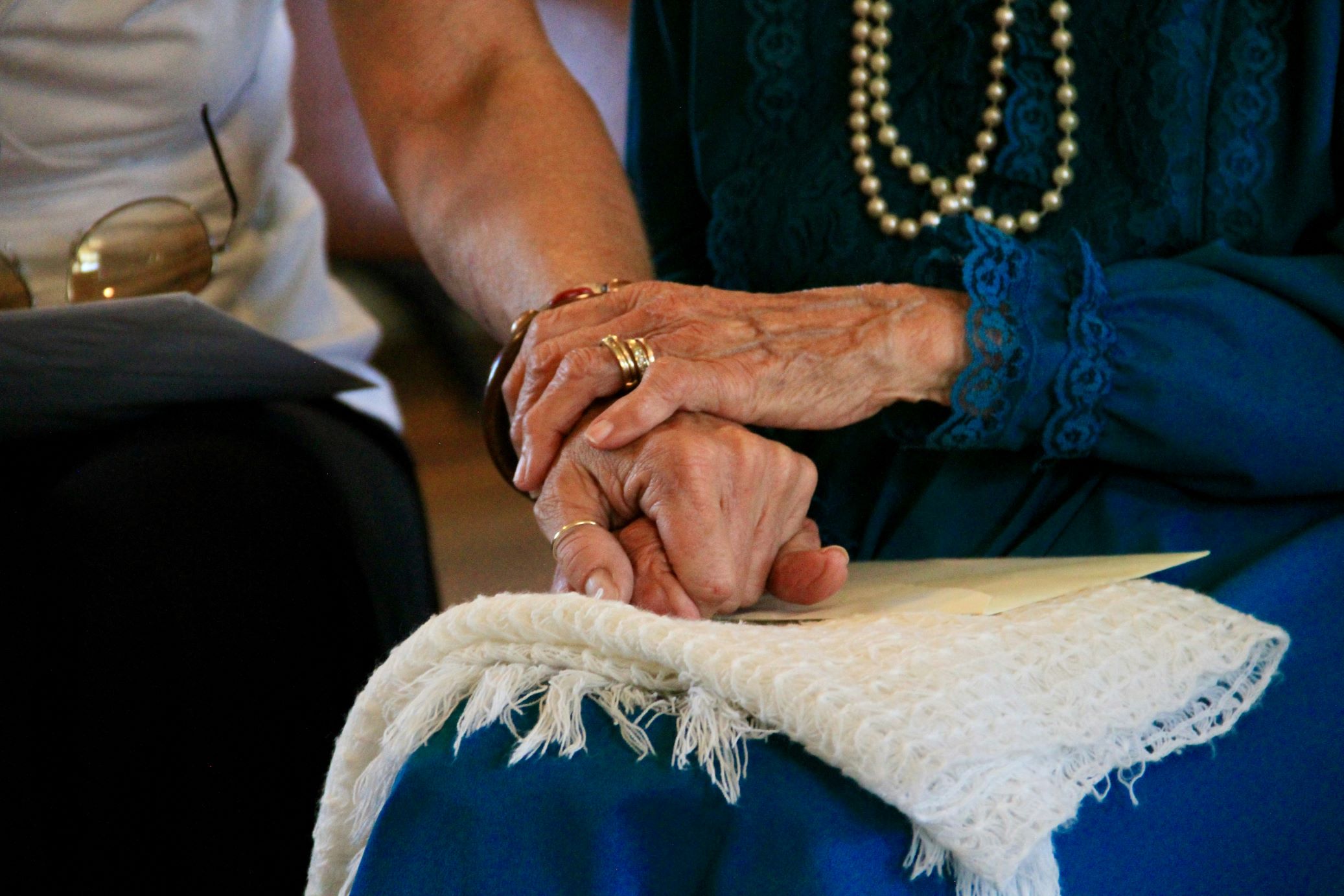 Takeaways
Takeaways
- Many older adults become caregivers for their spouses or partners. This can be challenging as the caregiver may also be dealing with their own age-related health issues.
- Family caregivers are providing more intense and longer-term care, often involving physically demanding tasks and complex medical duties, for which they rarely receive training.
- Older caregivers often experience physical strain, emotional stress, and isolation, and neglect their own health.
Most people tend to marry someone who is within a few years of their own age. As a result, many married couples share the same cultural touchstones, social memories, and general values. Certain phases of life often coincide as they grow older together, as they may share similarly timed career paths and enter retirement around the same time. These overlapping life trajectories can also mean that they develop age-related ailments around the same time.
Age-related ailments often require long-term care. This can include needing help with bathing, dressing, feeding, handling finances, scheduling appointments, and transportation. In many cases, an unpaid family caregiver provides this support.
According to the Caregiving in the U.S. 2025 report published by AARP and the National Alliance for Caregiving, nearly a quarter (22 percent) of family caregivers in the U.S. are 65 or older. Fifteen percent of them are caring for a spouse or partner.
The scenario in which a spouse or partner fills the role as family caregiver may seem ideal. After all, no one knows the care recipient better than the person they have lived with for years. However, if the caregiver and care recipient are close in age, as is often the case, the caregiver may be sacrificing their own well-being by trying to fulfill the needs of their closest loved one.
Care Recipients and Common Age-Related Ailments
Care recipients are mostly older adults, with nearly half being 75 or older. Many older adults are living with multiple chronic health conditions, such as mobility limitations and general age-related decline. Cognitive issues are prevalent among care recipients, with 27 percent of caregivers reporting that their care recipient has Alzheimer’s, dementia, or another memory-related impairment.
High-Intensity Care
The day-to-day support that family caregivers are providing has become more intense and a longer-term commitment. According to the report, 30 percent of caregivers provided care for five or more years, a significant increase from 2020. Caregivers spend an average of 27 hours per week providing care, and 24 percent provide 40 or more hours per week.
Two-thirds of caregivers assist with at least one activity of daily living (ADL). For many caregivers, these tasks, which can include bathing and moving the care recipient, are physically demanding. Twenty-three percent of caregivers reported that they struggle with these tasks.
More caregivers are also helping with multiple instrumental activities of daily living (IADLs) than 10 years ago. IADLs can include shopping, preparing meals, managing finances, and providing transportation. In addition to handling ADLs and IADLs, many caregivers shoulder medical tasks such as giving injections, managing catheters, and monitoring vital signs. More than half of caregivers perform these types of tasks, yet only 22 percent have received training for them.
Forty percent of caregivers reported providing a level of care that can be considered high-intensity. This can mean that the caregiver is providing many hours of especially involved or physically taxing support each week. High-intensity care includes:
Medical and Nursing-Type Tasks
- Wound care or dressing changes
- Giving injections (e.g., insulin)
- Managing IV lines or feeding tubes
- Monitoring and operating medical equipment, such as oxygen machines
Hands-on Personal Care
- Bathing and dressing the care recipient
- Helping with toileting and incontinence care
- Assisting with eating and drinking, especially if there are swallowing difficulties
- Transferring the care recipient in and out of bed, a wheelchair, or a car
Extensive Health Management
- Tracking multiple medications with complex schedules
- Coordinating with multiple doctors, therapists, and specialists
- Handling medical crises or frequent trips to and from a hospital
Around-the-Clock Supervision
- Staying alert to prevent falls or wandering (common in dementia care)
- Being on-call overnight for emergencies or symptom management
These tasks are especially challenging for older caregivers because they may require physical strength, medical skills, and sustained vigilance — all while the aging caregiver is likely managing their own health conditions.
How Caregiving Affects Older Caregivers
Though caring for a loved one can give a family caregiver a sense of purpose and possibly strengthen the bond they share, it can also negatively affect the caregiver. According to the report, 20 percent of caregivers rated their health as fair to poor. Nearly a quarter of them indicated that their caregiving responsibilities prevented them from adequately caring for themselves.
Providing care can cause physical strain, especially in older caregivers whose bodies may be just as old as the people they are caring for. The study found that 45 percent of caregivers experience moderate to high physical strain. Research has shown that older family caregivers, Alzheimer’s or dementia caregivers, those who are living with their care recipient, and caregivers who provide care for a year or longer are more likely to rate the strain of caregiving as high.
In addition, family caregivers have to manage the emotional stress that comes with observing a loved one’s decline while trying to meet the loved one’s needs. Among the caregivers in the Caregiving in the U.S. 2025 report, nearly two-thirds reported moderate or high emotional stress.
A feeling of isolation can be common with caregivers as well, especially in situations where the care recipient has dementia and family members who could help live far away. Nearly one in four caregivers reported feeling alone in the 2025 study.
Despite these costs, 51 percent of the family caregivers surveyed said that caregiving gave them a sense of purpose in life. The Guardian tells the story of Australian Don Cameron, who is nearly 80 and cares for his wife, Marjorie, who lives with dementia and mobility issues.
Cameron told The Guardian that he no longer has time for himself and neglects doing things that he enjoys. His biggest concern, though, is what would happen to his wife if he had a health issue that prevented him from caring for her.
Ways to Support Family Caregivers
Family caregivers provide countless hours of unpaid care every year while facing considerable personal and financial challenges. As more Americans require long-term care, the need for meaningful support for caregivers will increase. The Caregiving in the U.S. 2025 report highlights some policies that can benefit family caregivers, including:
- Financial support policies. These could be in the form of an income tax credit for caregivers, payment for at least some of their caregiving hours, or a partially paid leave of absence from work for employed caregivers.
- Respite services. Breaks from caregiving duties can help family caregivers rest, recharge, and tend to their own health.
- Check-ins with medical professionals. Family caregivers expressed an interest in a doctor, nurse, or social worker asking them about what they need to help care for their loved one as well as themselves.
- Training and information. The report found that many family caregivers would benefit from training on topics such as managing stress, keeping their care recipient safe at home, managing personal finances, and making end-of-life decisions.
Older family caregivers, many of whom are facing their own health challenges, limited financial resources, and social isolation, are performing critical work that often goes unrecognized. When older adults give care, they often pay the price — physically, financially, and emotionally. Recognizing this growing phenomenon and finding ways to address it will help family caregivers and their care recipients live healthier, less stressful lives.


